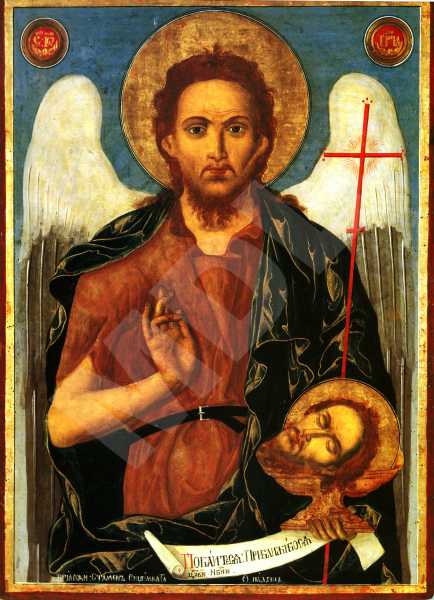St. John the Forerunner
Type:
Icon
Period:
1816 year
Dimiter T. Molerov, born in 1780 in Bansko, son of Toma Vishanov the Moler. One of the best-known painters, a representative of the Bansko school of art, a disciple of his father, influenced by the art of Athos. Author of the murals of the naos in the St Archangels' paraclete in the Rila monastery, the murals in the Church of the Assumption of the Virgin in the Pchelino dependance. In 1840 and 1841 together with his son Simeon Molerov he paints the murals and the sponsors' portraits in St. Nicholas' and St. John of Rila's paracletes in the principal church in the Rila monastery. Among D. Molerov's major achievements in iconography are the following icons: St. Nicholas (1816) from St. Archangel Michael's church in the village of Leshko, Christ All-triumphant with Angels and Cherubim (1833), The Nativity and a Crucifixion from St Elijah the Prophet's church in the village of Usenovo. He has also worked in Belgrade on an invitation by Prince Milosh Obrenovich of Serbia. He died in 1870 in Bansko.
Dimmensions (cm):
79
/ 59
/ 2.5
Location
Country: Bulgaria
Province: Blagoevgrad
Village: Leshko
Church: St. Archangel Michael
Source
Country: Bulgaria
Province: Blagoevgrad
Village: Leshko
Church: St. Archangel Michael
Description
Compositionally, the icon is developed in the typical of that theme iconographic cliche
Iconographical technique: Combined
The technique of the painting is a combined one, with velaturas and gilding, typical of the icons of the Revival Period, painted in this region. The painting layer is relatively unimpaired, missing in some places, together with a part of the ground coat. In the more thinly applied places (mostly in the dark colors) the painting looks like having been washed. The varnish cover had been thinly laid and is heavily soiled.
Base material: Wood
The base is a softwood panel, reinforced with two beams. The ground is of plaster, relatively unimpaired. It is damaged in the field of the frame, along the metal covers of the raised hand and on the two aureoles of the saint's head.
State, restoration traces and comments
The icon used to have three metal covers: over the hand, the aureole and the cup, which had subsequently been removed. Soilures, most probably from vegetable oil, have been found in an additionally laid varnish.


